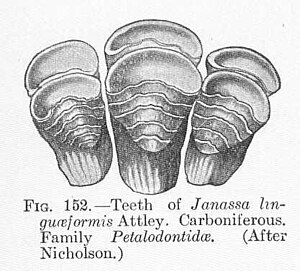Petalodontiformes
| Petalodontiformes | ||||||||||||
|---|---|---|---|---|---|---|---|---|---|---|---|---|

Teeth of Janassa linguaeformis |
||||||||||||
| Temporal occurrence | ||||||||||||
| Mississippian (Lower Carboniferous) to Rhaetian (Upper Triassic) | ||||||||||||
| 360.7 to 199.6 million years | ||||||||||||
| Locations | ||||||||||||
|
worldwide |
||||||||||||
| Systematics | ||||||||||||
|
||||||||||||
| Scientific name | ||||||||||||
| Petalodontiformes | ||||||||||||
| Zangerl , 1981 |
The Petalodontiformes , also called Petalodontida , are an extinct group of cartilaginous fish , which is mainly known from fossil teeth finds and occurred from the Lower Carboniferous to the Upper Triassic. The teeth are wide, have flat, diamond-shaped surfaces and probably formed strong plaster teeth that were suitable for crushing hard-shelled prey. Each tooth had a long root, which in some cases was also divided.
In the few cases in which the body contours are preserved in fossil form, they often show ray-like, flattened fish with greatly enlarged pectoral fins. The best known genus Belantsea , on the other hand, is high-backed.
It is believed that the Petalodontiformes are distant relatives of today's sea cats (Chimaeriformes).
Internal system
- Belantseidae family
- Genera Belantsea , Ctenoptychius , Netsepoye
- Family Janassidae
- Genus Janassa
- Family Petalodontidae
- Genera Itapyrodus , Janassa , Petalodus , Polyrhizodus
- Family Pristodontidae
- Genera Megactenopetalus , Peripristis , Petalorhynchus , Pristodus , Siksika
-
incertae sedis
- Genres Antliodus , Brachyrhizodus , Cynopodius , Euglossodus , Fissodus , Glyphanodus , Mesolophodus , Paracymatodus , Serratodus
literature
- John A. Long: The Rise of Fishes . The Johns Hopkins University Press, 1995, ISBN 0801849926 .
- Joseph S. Nelson : Fishes of the World , John Wiley & Sons, 2006, ISBN 0-471-25031-7 .
- Alfred Romer : Vertebrate Paleontology. The University of Chicago Press, 1955, ISBN 0-2267-2488-3 .
Web links
- The Paleobiology Database Petalodontiformes